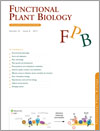
Functional Plant Biology
Volume 44 Number 8 2017
FP16443Vacuolar convolution: possible mechanisms and role of phosphatidylinositol 3,5-bisphosphate
Reversible shrinking of the vacuole (vacuolar convolution) has been suggested as an adaptive mechanism of plants against high soil salinity and drought. Mechanisms of vacuolar convolution are poorly understood, mainly because of difficulties in examining the vacuole in its native environment. Elucidating these mechanisms may help in obtaining better drought and salinity resistance in crops in the face of climatic changes.
FP17026Multiple mechanisms mediate growth and survival in young seedlings of two populations of the halophyte Atriplex halimus (L.) subjected to long single-step salinity treatments
We urgently need to find solutions to the increasing problem of saline soils, which reduce crop productivity and lead to desertification. Atriplex halimus (salt brush) is a highly salt tolerant plant: we find populations from contrasting salinity environments switch on internal coping mechanisms at different times. Understanding how salt tolerant plants cope with salt stress will help us select the best plants for re-introduction into saline-affected areas.
FP16356Acclimation to light and avoidance of photoinhibition in Typha latifolia is associated with high photosynthetic capacity and xanthophyll pigment content
Acclimation of leaf structure and photosynthesis are important responses to light availability but have not been widely investigated in plants with tall, linear leaves. Here, the tall wetland plant Typha latifolia acclimated to high light with high photosynthesis rates and investment in pigments that avoid damage by excess light. These findings help explain why these plants are more highly productive than many other species.
FP16381Maximised photosynthetic capacity and decreased hydraulic failure risk during aging in the clump bamboo, Bambusa chungii
The survival strategies of bamboo species are driven by the changed precipitation pattern and seasonal drought. In this paper, we demonstrate the anisohydric behavior of Bambusa chungii stomata to maximize carbon assimilation, and show that that they exhibit structural compensation to maintain the hydraulic safety during the whole period of senescence. These results suggest that bamboo species could be dominant in the forest ecosystems in the future.
FP17073An analysis of the role of the ShSUT1 sucrose transporter in sugarcane using RNAi suppression
Sucrose transport within a plant involves the uploading of sucrose in the source tissue and unloading in sink tissue. The production of transgenic plants assisted with identifying the role of a sugarcane sucrose transporter in the sucrose mobilisation pathway. This sugarcane sucrose transporter does not directly load sucrose for transport but likely retrieves sucrose from intercellular spaces in both source and sink tissue.
FP17029Genotypic variation in carbon fixation, δ13C fractionation and grain yield in seven wheat cultivars grown under well-watered conditions
Leaf photosynthesis is intimately associated with plant biomass production, yield development and the global carbon cycle. Biotic carbon sequestration is being considered a viable option for mitigating increasing atmospheric carbon dioxide emission, where photosynthesis plays a significant role. The wheat variety; WH-1021 with higher photosynthetic efficiency, δ13C isotopic discrimination, stomatal frequency and grain yield can be recommended for climate smart agriculture.
FP17105Cellulosic fibres of flax recruit both primary and secondary cell wall cellulose synthases during deposition of thick tertiary cell walls and in the course of graviresponse
The machinery to synthesise the most abundant component of the biosphere – cellulose, is considered to involve distinct sets of CESA proteins to form primary versus secondary cell walls. Analysis of gene co-expression revealed that cellulosic fibres harbour both CESA sets while depositing tertiary cell wall. Thus, the original dogma needs refining and the mechanism to fine-tune cellulose synthesis organisation needs further elucidation.
FP16435Insights into the functional relationship between cytokinin-induced root system phenotypes and nitrate uptake in Brassica napus
Root system architecture is the spatial arrangement of roots that impact the capacity of plants to access nutrients and water. We employed pharmacologically generated morphological and molecular phenotypes and used in situ 15N isotope labelling to test the hypothesis that the contrasting root traits were functionally related to N acquisition. We demonstrated that root proliferation in response to external nitrate is a behaviour which integrates local N availability and the systemic N status of the plant.



